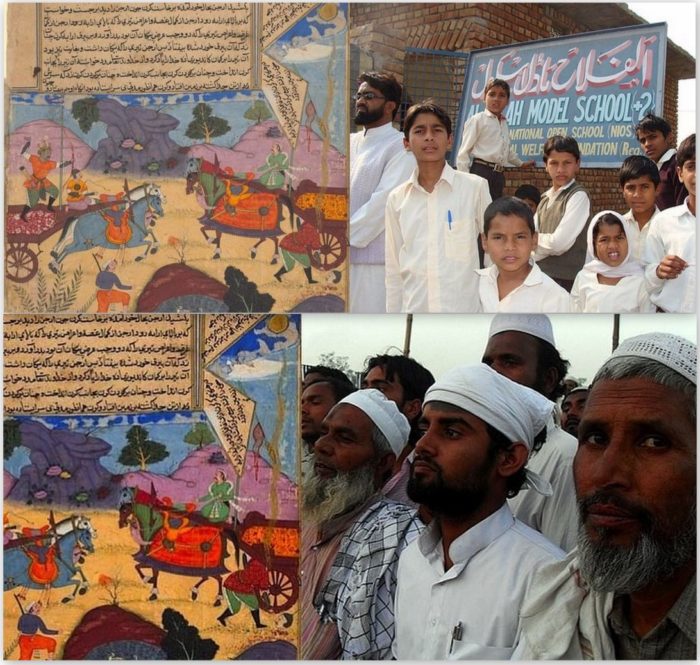After the violence of Republic Day carried out by fringe elements, which was intended to malign the Farmers’ movement, there were doubts about the continuity of the protests when police and paramilitary troops were sent to the protest sites, with a special focus on Ghazipur, where farmer-leader Rakesh Tikait had held his ground. But, the emotional turn of events, when tears rolled out of Tikait’s eyes, took the farmers’ movement on a resurgence, with countless farmers started rallying towards the protest sites. That led to the next phase of the movement where Mahapanchayats began to be called.
The first Mahapanchayat was held at Muzaffarnagar, where it was decided that the protest at the Ghazipur would continue irrespective of the orders from authorities. That led to a surge of protesters at the Singhu and Tikri sites as well, along with the flow of protesters among the three sites. On the night of January 28, Rakesh Tikait declared that even if the water supply is cut off, then also the protests would continue, adding that either the laws would be repealed or he would give up his life. That call was not less than a war-cry in the eyes of the protesters assembled at Ghazipur and other sites. Multiple Mahapanchyats were called and people, mostly from farming community thronged at the Mahapanchayats boosting up the crest of the caps of the movement.
Gradually, South Haryana got fully integrated into the Kisan movement, especially after the Ghazipur episode of RakeshTikait against the three black farm-laws en masse. That geographical area is part of the Mewat region which has a rich historical backdrop running through centuries beginning from Mahajanpada era in ancient times, when it was known as Matsya Kingdom (founded in 5th century BC).
Also See: An overview of farmers’ protests- role of Charan Singh
History of Mewat
Mewat is a region that has been witness to the coalescing of people of different cultures and emergence of community with different definitions on modern religious lines but having a common socio-cultural root. It is a region in Haryana, West UP & Rajasthan with an approximate boundary that includes Nuh district & Hathin tehsil of Haryana, Alwar & Bharatpur districts in Rajasthan & Chhata tehsil of Mathura district in UP. In medieval times, Khanzada Rajput people were rulers of Mewat. They used the title of Wali-e-Mewat from 1372, when Firuz Shah Tughluq was the sultan in Delhi till 1527, when the decisive Battle of Khanwa was fought by the founder of Mughal empire in India, Babur. This battle has an important connection in the overall history of Mewat and Meo-Muslims of that region, which will be discussed.
The Mewat region is populated mainly, by Mewati (Meo) Muslims, Yadavs, Jats, and Rajputs. The Southern Haryana region is subsumed in Mewat, a bastion & stronghold of Meos. Parts of old Mewat now fall in Alwar and Bharatpur districts in Rajasthan. Mewati muslims, who speak the Mewati language are demographically populated and centred in Mewat including Alwar & Bharatpur. Their historical background points to the helplessness of the government to isolate & subdue them for participating in the farmers’ protests that are spearheaded by farmer-leaders from Punjab. The connection of Meos with Mewat is crucial to the strong sentiments behind the farmers’ protest-movement which now binds communities across age groups & geographies. Meo history testifies to this connection.
Who are Meos
Though the Meo community profess faith in Islam, but sociologically it has its roots in the Hindu society of North-West India. They have a common origin and similar cultures with Ahirs, Minas, Rajputs, and Meenas. In the Mewat region, the Hindu residents belong to the same caste-categories to which Meo-muslim belonged prior to their conversion to Islam. The Meos had amalgamated into a common community after their conversion to Islam between the twelfth and the sixteenth centuries, with their roots in high-caste Rajput culture. Names like Fateh Singh & Ram Singh are common names among Meos, which point out the still present connection with their past, which they cherish & respect.
We shall now revisit the year of 1527. Mewatis are particularly proud of the historical fact that Hasan Khan Mewati, their clan leader had fought with Rana Sanga, and against Babur, in the Battle of Khanwa in 1527. Babur who was of central Asian origin and Chagatai Turkic descent had lost Samarkand and his birthplace Fergana to Uzbeks. His attention then turned to India. He won the first Battle of Panipath in 1526 against Ibrahim Lodhi, giving him control over Delhi. When Babur decided to gain & consolidate his hold over north India, Rana Sangha, a Hindu King formed the first challenge for him. And, in support of Rana Sangha, stood Hasan Khan Mewati, a Meo-ruler, who ruffled the intentions of Babur to draw him out of alliance with Rana Sangha. The alliance of Rana Sangha was formed of Afghans led by Mahmud Lodhi, Maldev Rathore from Marwar, and Rajput rulers of Harauti, Jalor, Sirohi, Dungarpur, and Dhundhar, Rao Medini Rai of Chanderi, & Hasan Khan Mewati. Though this alliance was defeated, it provided an episode in the folk memory of Mewati Muslims about their sense of brotherhood with other residents of the region and states like Rajasthan & Haryana. This was a unique case of a syncretic army, which even through its defeat provided memories to be cherished by generations to come in those communities that participated in that battle side by side going beyond the religious identities.
Fight of Meos with British
After the Mughals, the period of British dawned upon India through deindustrialization of Bengal, and subduing of UP region, Odisha, Bihar, and Bengal through chicanery. The suppressed anger of the populace & soldiers under the East India company’s domination exploded in the form of the cathartic & bloody revolt of 1857. The planning of the joint launch of the revolt was spread across vast swathes of North, East, Central, and West India, through the use of Atta for chapattis and flower, through the hands of a Hindu sannyasin saint or a Muslim fakir. In every village and town such saints or fakir went, they brought with them a lump (kneaded dough) of Atta (wheat). The villagers would make chapattis using that lump and would pass on another lump to that saint, who would then take it to another village, along with a fresh flower. This rite was considered a silent way of assuring that the village would jump into the revolt. The revolt actually broke out in pulses rather than as a concerted effort. The inferno of the revolt had reached towards North-West of India, though it took some days. Nevertheless, Mewatis without losing any time jumped into the rebellion. They faced challenges from three sides or fronts. On the first front, the Mewatis had to fight against the British army and police. On the second front, they had to fight against the servile loyalists British such as the Khanzadas of Nuh, the Rajput of Hondsi & Hathin, and the Rawat jats of Hotel and the Kayasth of Sahna. On the third front, they had to fight against the Army of the British loyalists states such as Alwar, Bharatpur and Jaipur. It is also on record that during the revolt along with Jat allies and Sepoys, Meos fought even their own people, the pro-British Khanzads of Nuh. Meos and 300 sepoys from Delhi sent by Bahadur Shah Zafar in an alliance in Gurgaon had killed Clifford, the assistant collector of Gurgaon, and 60 British soldiers.
The Meos were able to unseat the power of the East India company from the regions of the Mewat under Haryana and had loosened up the hold of the British over Alwar and Bharatpur in Rajasthan. Under the leadership of Sadruddin Khan Mewati in Nuh, Meos had waged an unrelenting guerilla war. The British had massacred thousands of Meo men, women, and children. Even after paying this much cost in terms of human lives, the counter-attack from Meos was fierce and the guerilla war had lasted well beyond the fall of Delhi at the hands of British led by John Nicolson and Archdale Wilson. There were many notable battles & victories (of Meos) in the revolt of 1857 which highlight the stand taken by Meos against the British. Meos had won several battles, at Hathin, south of Faridabad, under the leadership of Ali Hasan Khan Mewati, an artilleryman. Around 3000 Meos had fought at Rupraka, Palwal, against a large British force under Captain William George Drummond Stewart. Meos had also pounced upon a British force sent to ‘tame’ the Mewat area, routing out the British force in another famous battle, at Hodal, Punhana (Nuh district). They had also taken part in the battles of Jhajjar, Firozepur Zirka, Bahadurgarh, and the areas of Alwar and Bharatpur during the rebellion months. The participation of Meos in the decisive battle of Narnaul on November 16, 1857, under the leadership of Yadav warrior Rao Tula Ram, was noticeable. More than 6000 Meos had lost their lives in the fight against the East India Company during the revolt.
Rulers of Alwar and Bharatpur states, Raja Sawai Vinney Singh & Raja Jashwant Singh respectively had sided with the British by providing them tactical support. Sawai Vinney Singh had sent some of his troops to the Agra unit of East India Company forces. Their loyalty was expected to be rewarded, and the rebellious Mewatis were to be punished. So it was decided that some portion of the Mewat region would be divided away. Subsequently, parts of Mewat were given to Alwar and Bharatpur by the British, after they scrambled to regain hold and control in the fallout of the revolt. Meo Muslims had also played a huge part in the 1857 peasant uprising against the British East India Company Raj, which had brought systems like Permanent settlement, Ryotwari system, and Mahalwari system. The first system was basically the Zamindari system which was made prevalent in eastern regions like Bengal, Bihar and Orissa. The second system of Ryotwari was established in the southern states and the third system (Mahalwari) was established in the North-Western regions like Mewat. All the English systems of land revenue targeting the agricultural sector had reversed the ownership of the farmers and peasants over their lands which was institutionalized under the Mughals. These revenue systems on a common ground demanded a back-breaking amount of lagaan in the form of food-grains, which if not paid was considered treachery towards the British, and had led to the impoverishment of countless farmers, whose fore-fathers flourished under the Mughal rule. This same reversal of ownership and the control over the food-grain market are among the fears which are driving the farmers’ protests in which the Mewati-Meos are participating. Only the people with a feeble hold over the agriculture’s history or heads dunked inside the sand would not see the parallels.
Persecution of Meos
Mewat & Meo’s history of communal harmony, syncretism and cultural amalgamation as highlighted in the periods of Mughal’s arrival in India and during the Revolt of 1857 did not protect them from the Alwar-Bharatpur rulers who persecuted Meos, prominently in 1931 and 1947. Raja of Alwar, Jai Singh, who ruled Alwar from 1903 to 1933 & famous for buying Rolls Royce to pick up garbage, is also known for the persecution of Meos in 1931 on behalf of the British. Apart from Jai Singh, Kishan Singh of Bharatpur was also into persecuting Meos. Jai Singh & Kishan Singh also provided patronage to Shuddhi movement of conversion of converted-Muslims back into Hinduism. Chaudhury Mohammed Yasin Khan had risen for Meos, against Jai Singh, who was considered as a British puppet by Meos. This episode of 1931 gave Meos a community feeling. In 1933, an agitation by the Meos against the oppressive taxes by Raja Jai Singh of Alwar had led the English to depose the Raja. It is another parallel where agitation & protests had won the day for the commoners against the unjust tyrants.
Connection of Meos with Gandhi & Subhash Bose
On December 19, 1947, Gandhi had visited Ghasera in Mewat to prevent the occurrence of communal violence against Meos. He had urged Meos to not leave India. A significant portion of the Meos had then refused to migrate to Pakistan. The village is now known as Gandhigram Ghasera. In the aftermath of the partition, Meos had to deal with a position of being neither citizens nor refugees in the period from March to June 1948. An important monument of Meos, Fateh Jung ka Gumbad was desecrated in Alwar in the aftermath of partition. After assassination of Gandhi at the hands of Godse, Meo women-folk had sang the song, “Bharosa utth gaya Mevan ka, goli lagee hai Gandhiji kay chathee beech”, which points out how much they were hurt at his death. Many among Meos believe that one reason for the assassination of Gandhi was his sympathy for the Meos.
The history of Meos, during the troubled years of partition, has been best encapsulated by the works of Siddique Ahmad, a Meo historian. His work along with the works of another historian of the region, Shail Mayaram, points out to the aspect of ethnic cleansing of the Meo-Muslims. In 1947, around 30,000 Meos were killed in the princely state of Bharatpur, as per official figure. No records were available for Alwar. Both the states accounted for a total of 200,000 Meos, who were evicted, butchered, or slaughtered by mobs of multi-caste hindutva fanatics known as dhars. Most of the Meo villages were razed down and the survivors were subjected to Shuddhi. These were carried out by the princely states with significant Meo population in NW India.
In a parallel theatre during the independence movement in a different location, Meos, proved their strong sense of nationalism through blood by fighting in Subhash Chandra Bose’s Azad Hind Fauj by fighting along with soldiers from other communities.
With all these events in their history & in their endurance to choose to stay in India, their association with the farmers’ protests adds credence to their emotional connection to the soil.
Adding Resilience to farmers’ protests
Ramzan Chaudhary, one of the Meo-leaders, and the head of Jai Kisan Andolan’s Nuh unit had led a tractor rally towards Palwal and was stopped by police. His leadership had managed to gather a large number of farmers into the movement.
Apart from Muzaffarnagar enormous rallies in the form of Kisan Mahapanchayats took place at Chakhri Dadri, Mathura, Amroha, Sisauli, Sikar, Kharkhoda at Sonipat, Barnala, Karauli. The massive gargantuan Kisan Mahapanchayat in the Mewat region of Haryana, addressed by Gurnam Singh Chadduni and AIKS leaders was not less than historic. Farmer-leaders at Charkhi Dadri mahapanchayat had asserted that the Haryana government needs to be shocked by unseating them from the Vidhan Sabha. After the emotional turn of events around Rakesh Tikait, a large Mahapanchayat was organized at Naujheel region in Mathura where Rashtriya lok dal leader Jayant Chaudhary was present asserting his support for the farmers’ movement.
Also See: Overview of the Farmers’ unions in the protests
Mahapanchayats add a social cohesive value to the farmers’ movement by bringing everyone from disparate backgrounds on the same platform. That leads to the ways & events in which perceived protests turn into incredible movements. An example of such cohesive impact was seen when a panchayat in early February decided to use mikes of temples to make announcements to counter the internet ban by the government to muzzle the movement. That small event showed that when a large number of people stand united through their zeal, backed by the history, such gathering has the potential to unseat anyone from the comfort zone of nonchalance. The farmer-leaders were clever to use their united stand, amplify it using the Mahapanchayats, and extend it in other states, especially where BJP is contesting elections, which would definitely impact the electoral outcome. The Ghazipur Mahapanchayat sustained the protest and essentially changed it into a movement by the sheer number of the people participating in the gatherings, including Meos who joined forces, considering their resilient past linked to the soil they till.
The current government working much like the British has tried to silence the voice of the farmers with whom the Meos stand, apart from the farmer-leaders from Haryana, Rajasthan, UP, and Punjab. But the resilience, tenacity & endurance of communities like Meos give a life-force to the movement which cannot be suppressed by any amount of authoritarianism.





